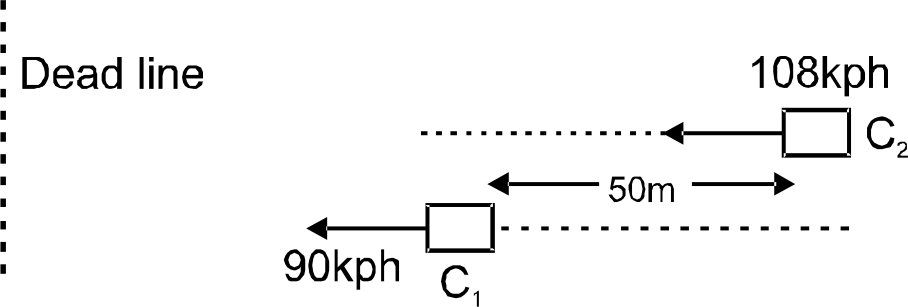Two cars C1&C2 are moving in parallel lanes in the same direction at speeds 90kph&108kph respectively (see figure). As the traffic signal turns red, both applies brake (assume constant retardation) simultaneously. If they both stop together at the dead line

distance of dead line from C2 is 300m
destance of dead line from C1 is 250m
time taken by the cars to ends up after the signal turn red is 15sec.
time taken by the cars to ends up after the signal turn red is 20sec.
The correct Answer is:A::B::D
(i) Relative initial velocity =5m/s, relative final velocity =0
Relative displacement =50m
Relative acceleration = constant
⇒50=(5+02)t⇒t×20sec.
(ii) Distance of dead line from car C1=(25+02)×20=250m.
Topper's Solved these Questions
Similar Questions
Two cars 1 and 2 move with velocities v1 and v2, respectively, on a straight road in same direction When the cars are separated by a distance d the driver of car 1 applies brakes and the car moves with uniform retardation a1, Simultaneously, car 2 starts accelerating with a2, If v1<v2, find the minimum initial separation between the cars to avoid collision between then.
View SolutionTwo particles of mass 1kg and 2kg are moving along the same line with speeds 2m/s and 4m/s respectively. Calculate the speed of the centre of mass of the system if both the particles are moving in the same direction.
View SolutionTwo particles of mass 1kg and 2kg are moving along the same line with speeds 2m/s and 4m/s respectively. Calculate the speed of the centre of mass of the system if both the particles are moving in the same direction.
View SolutionTwo blocks of masses m1=2kg and m2=4kg are moving in the same direction with speeds v1=6m/s and v2=3m/s, respectively on a frictionless surface as shown in the figure. An ideal spring with spring constant k=30000N/m is attached to the back side of m2. Then the maximum compression of the spring after collision will be

View SolutionTwo cars C1 and C2 moving in the same direction on a straight single lane road with velocities v1=12ms−1 and v2=10ms−1, respectively . When the separation between the two was d=200m, C2 started accelerating to avoid collision. What is the minimum acceleration of car C2 so that they do not collide?
 .
.
View SolutionTwo trains A and B are moving with speeds 20m/s respectively in the same direction on the same stright track, with B ahead of A. The engines are at the front ends. The engines of train A blows a long whistle.
Assume that the sound of the whistle is composed of components varying in frequency from f1=800Hz to f2=1120Hz, as shown in figure. The speed in the frequency (highest frequency - lowest frequency) is thus 320Hz. The speed of sound in still air is 340m/s.

The spread of frequency as observed by the passengers in train B is
View SolutionTwo trains AandB moving with speeds 20m/s and 30m/s respectively in the same direction on the same straight track, with B ahead of A. The engines are at the front ends. The engine of train A blows a long whistle.
Assume that the sound of the whistle is composed of components varying in frequency from f1=800Hz to f2=1120Hz, as shown in the figure. The spread in the frequency (highest frequency - lowest frequency) is thus 320Hz. The speed of sound in still air is 340m/s.
The speed of sound of the whistle is
View SolutionTwo trains AandB moving with speeds 20m/s and 30m/s respectively in the same direction on the same straight track, with B ahead of A. The engines are at the front ends. The engine of train A blows a long whistle.
Assume that the sound of the whistle is composed of components varying in frequency from f1=800Hz to f2=1120Hz, as shown in the figure. The spread in the frequency (highest frequency - lowest frequency) is thus 320Hz. The speed of sound in still air is 340m/s.
(4) The speed of sound of the whistle is
View SolutionTwo trains AandB moving with speeds 20m/s and 30m/s respectively in the same direction on the same straight track, with B ahead of A. The engines are at the front ends. The engine of train A blows a long whistle.
Assume that the sound of the whistle is composed of components varying in frequency from f1=800Hz to f2=1120Hz, as shown in the figure. the spread in the frequency (highest frequency - lowest frequency) is thus 320Hz. the speed of sound in still air is 340m/s.
The spread of frequency as observed by the passenger in train B is
View SolutionTwo trains AandB moving with speeds 20m/s and 30m/s respectively in the same direction on the same straight track, with B ahead of A. The engines are at the front ends. The engine of train A blows a long whistle.
Assume that the sound of the whistle is composed of components varying in frequency from f1=800Hz to f2=1120Hz, as shown in the figure. the spread in the frequency (highest frequency - lowest frequency) is thus 320Hz. the speed of sound in still air is 340m/s.
(5) The distribution of the sound intensity of the whistle as observed by the passengers in train A is best represented by
View Solution
